Web3: DeFi & NFT Interactions with Ledger Vault
Ledger Enterprise provides a seamless and secure institutional gateway to the world of web3. You can explore and interact with an ever-growing ecosystem of decentralized finance (DeFi), non-fungible tokens (NFTs), and many more decentralized applications (DApps).
Web3 Governance & Configuration
Ledger Enterprise offers a robust and flexible governance framework for all types of web3 interactions. Admins can choose to enable web3 interactions for any EVM account and configure policies for operators to interact with smart contracts and DApps. Click here for detailed instructions.
Web3 Access
Vault DApps
Vault DApps is your safe and trusted place to explore decentralized applications (DApps) directly from your Vault workspace. Using DApps within Ledger Vault offers you the highest possible smart contract interaction security level.
You can find the complete list of DApps supported on the Vault here.
WalletConnect
WalletConnect is an open-source protocol that allows you to securely connect your Ledger Enterprise Platform to a wide range of decentralized applications (DApps). You can find the full list of supported DApps on the WalletConnect website.
Vault Contract Interaction Panel
Our Contract Interaction Panel, lets Ledger Enterprise Operators interact with any Ethereum contract through a standard user-friendly interface. Find out more information on how to interact directly with any smart contract here.
Ledger Enterprise API
The Ledger Enterprise API lets you interact with any smart contract on the Ethereum blockchain. The transaction creation & approval endpoints make it possible to trade on decentralized exchanges, deposit liquidity on DeFi protocols, mint or transfer NFTs programmatically and at scale, all while using Vault EVM accounts and abiding by your web3 governance rules. See our API documentation
Web3 Security
Don’t trust, verify. Ledger Enterprise ClearSign offers unparallelled security for web3 operations. ClearSign lets users verify their web3 interactions on the Trusted Display of their Personal Security Devices, effectively preventing them from blind signing these transactions. You can read more about blind-signing and the risks associated with it here.
ClearSign Interactions with Smart Contracts
Ledger Enterprise offers ClearSign for:
- a list of supported Ledger Enterprise ClearSign contracts
- contracts of the ERC-20 (fungible token) standard
- contracts of the ERC-721 or ERC-1155 (non-fungible token) standard
When interacting with ClearSign contracts, Operators are prompted to review the exact nature of their smart contract transaction on their device trusted display. Ledger Enterprise interprets contract interactions in an easily human-readable format, so Operators can ensure the transaction details match their intent before approving them.
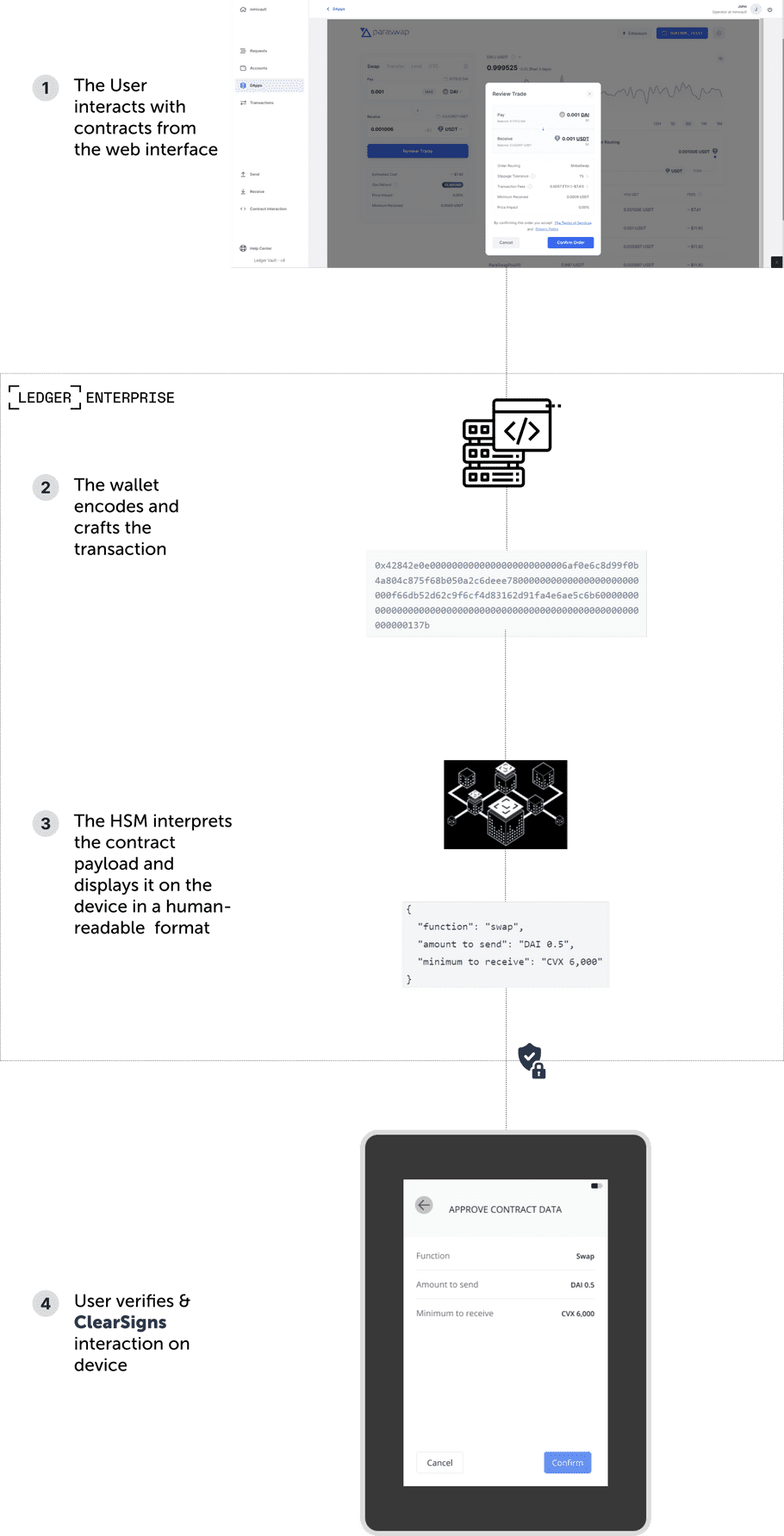
Whenever interacting with contracts supported by Ledger Enterprise ClearSign feature, Operators will be prompted to review the transaction details on device:
- 1st screen - General transaction information: as per any Ethereum transactions, Operators can review recipient data (contract name & address), account, ETH amount, fees;
- 2nd screen - Contract data: This second screen lets Operators verify the content of their contract interaction.
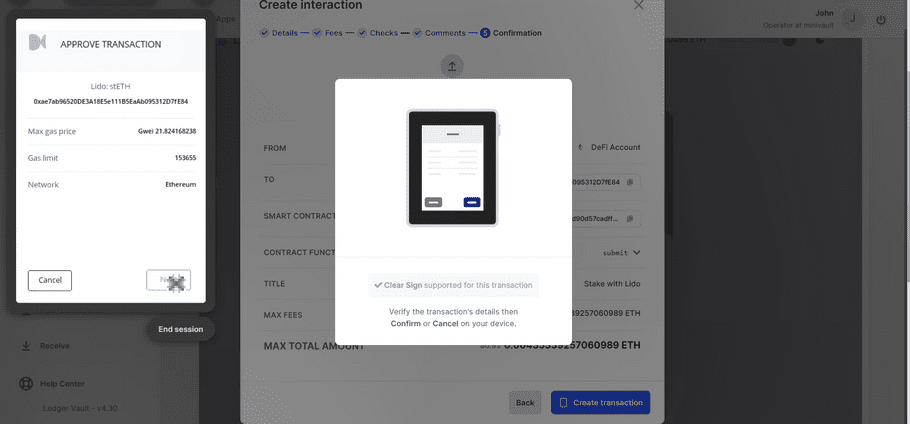
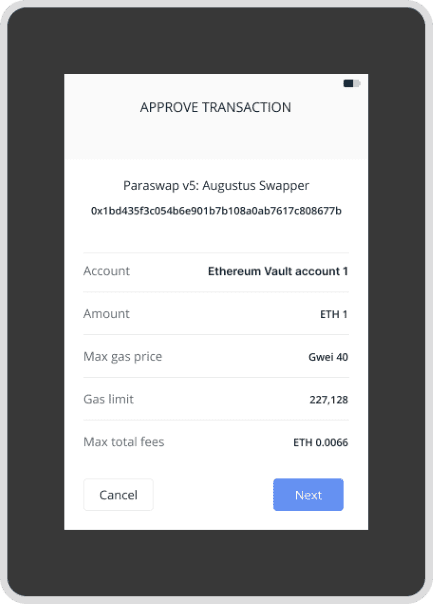
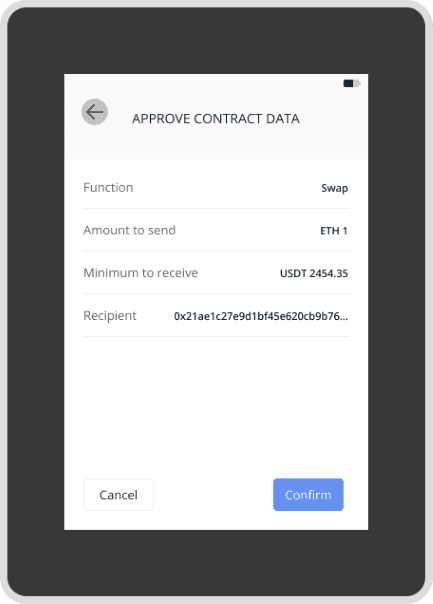
An example of a Clear-Signed transaction on Paraswap
When interacting with contracts which do not yet support ClearSign, Operators are prompted to blind-sign their transactions. You can identify blind-signed interactions with the following warning on your PSD: “Contract data cannot be displayed”. Please make sure that you trust the contract you are interacting with when blind-signing.

An example of a Blind-Signed transaction on a smart contract
We are working to extend our ClearSign contract coverage to all major DApps & contracts of the web3 ecosystem. Should you want Ledger Enterprise to support a specific application or contract, please reach out to your Technical Account Manager and we will make sure to prioritize accordingly.
ClearSign Message Signatures
Signing messages serves a crucial purpose in the web3 ecosystem. It allows users to confirm their identity, authenticate transactions, and interact with smart contracts without the need to share their private keys.
The EIP-191 and EIP-712 formats are Ethereum Improvement Proposals that standardize signed messages:
- EIP-191 provides a basic signed data scheme. It is mostly used to let users prove that they control an address without revealing their private key, typically when logging into a DApp.
- EIP-712 improves upon EIP-191 and makes the process of data signing more user-friendly. It displays the data in a structured and readable format, improving user understanding and control over what they are signing. It is used when users are required to sign complex data to interact with a decentralized application (DApp), for instance, when placing orders on NFT marketplaces, or to allow a DEX to swap their tokens.
Ledger Enteprise supports the signature of messages in the EIP-191 and EIP-712 formats, and enables operators to review their content on the Trusted Display of their Personal Security Devices
Web3 Operations Reporting
Smart Contract Interactions Reporting
You can monitor and audit your entire history of smart contract interactions.
Ledger Enterprise records the nature and outcome of smart contract interactions, as well as their web3 governance audit logs, and exposes them to all available reporting tools: transaction history, csv & API exports.
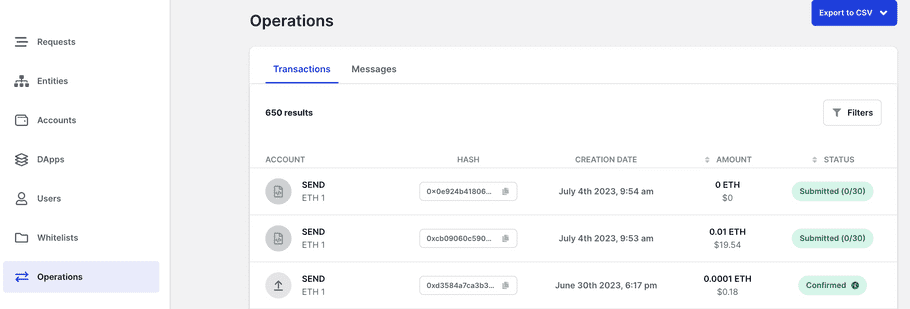
Transaction details:
-
Interactions with Ledger Enterprise Clear Sign DApps: the transaction overview tab specifies the contract interaction type: swap, stake, lend, etc.
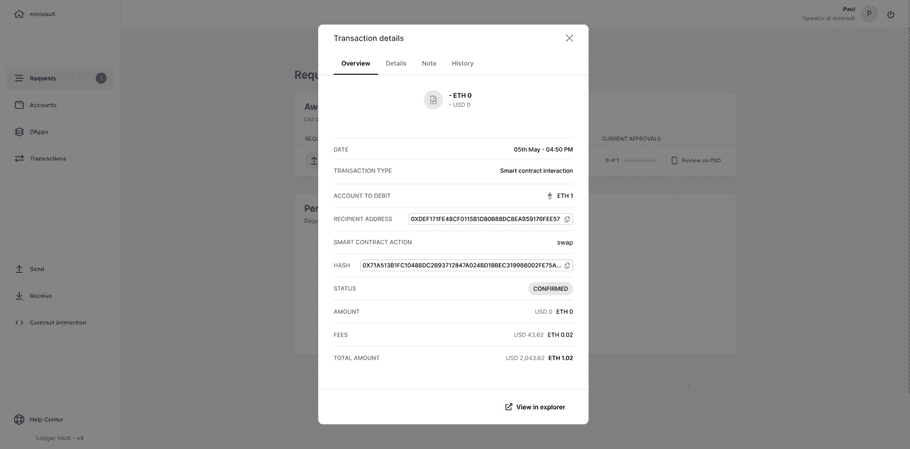
-
Additionally, the resulting transfer events of your smart contract executions are displayed in the transaction details; any ERC20, NFT or currency transfers are reported in the
Related operationssection, to enable you to better track and monitor your DeFi and NFT operations. This information is included into Full .csv exports as well ( Light exports do not include this data).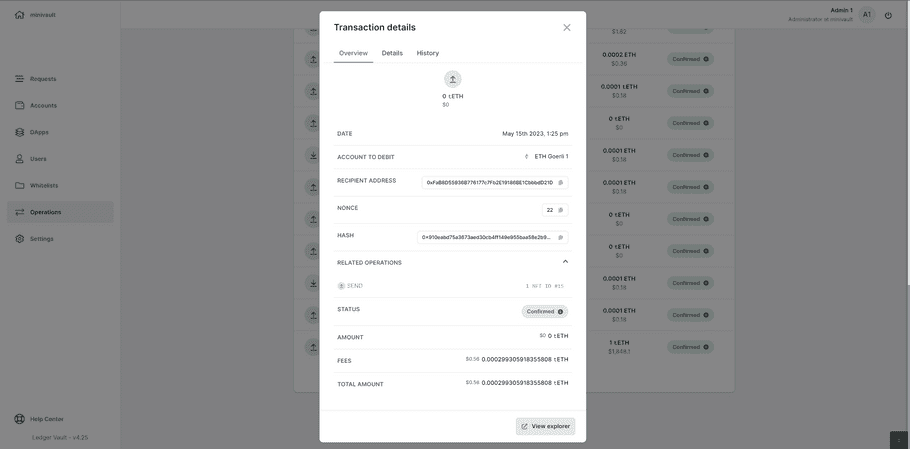
-
All smart contract interactions: the contract functions and arguments executed are always displayed in the Details modal, in both decoded human readable format, and raw hex encoded format
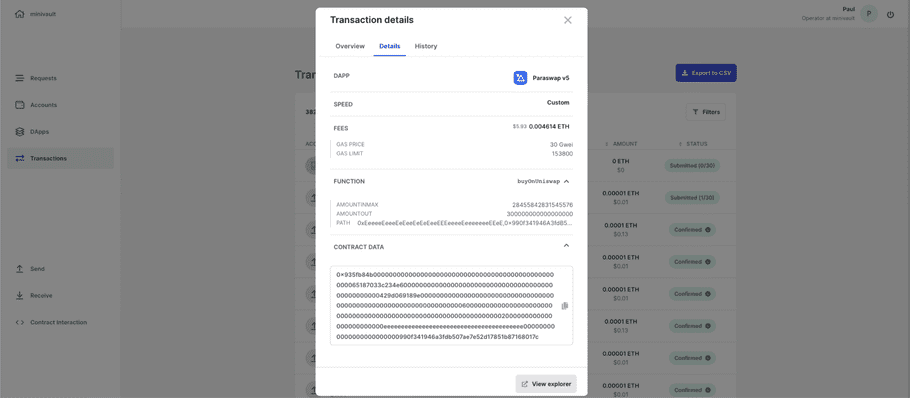
Message Signatures Reporting
You can monitor and audit your entire history of messages signed when interacting with DApps.
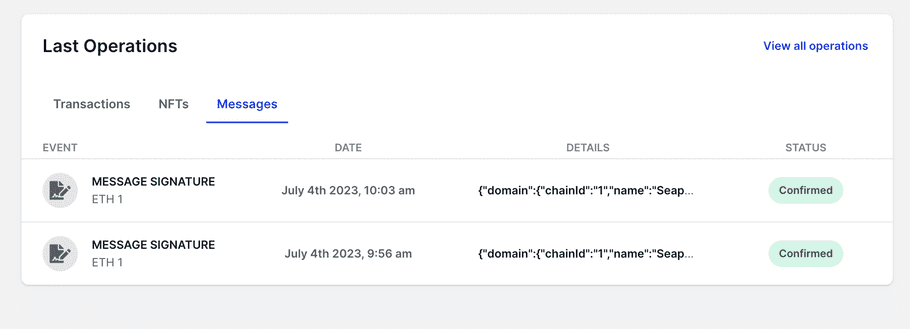
Ledger Enterprise records the message that was signed, as well as the message siging governance rule's audit logs.
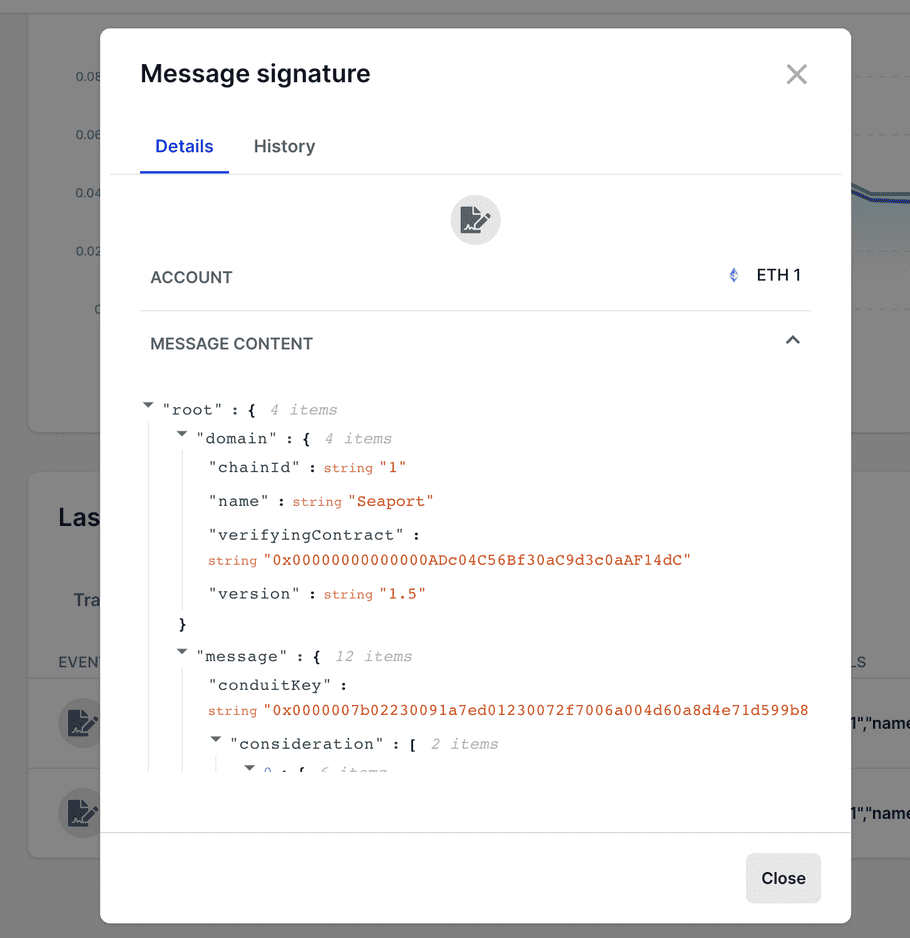
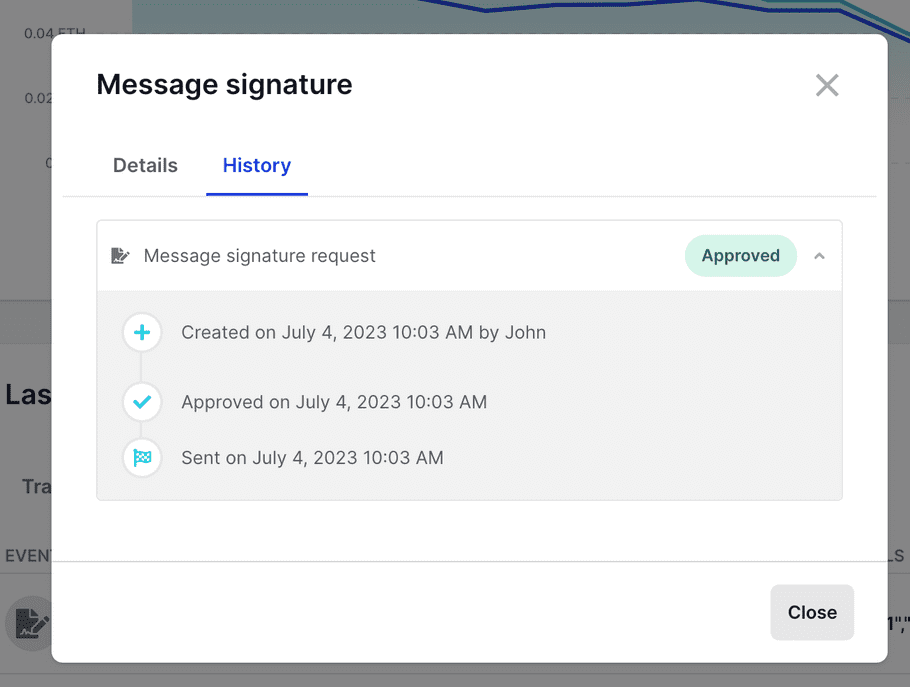
NFT Gallery & interactions
Ledger Enterprise lets you track and manage your NFT portfolio on Ethereum & EVM accounts:
- As an administrator , you’ll be able to simply toggle on or off the view of NFTs owned by an account in its settings. Find out exactly how to do so here: View NFTs on an ETH account .
- All operators listed in the Smart Contract rule of the account can send NFT tokens according to the steps outlined in the rule. This article outlines a step-by-step guide explaining the different steps of the send NFT operation: Send an NFT from the Account Gallery .